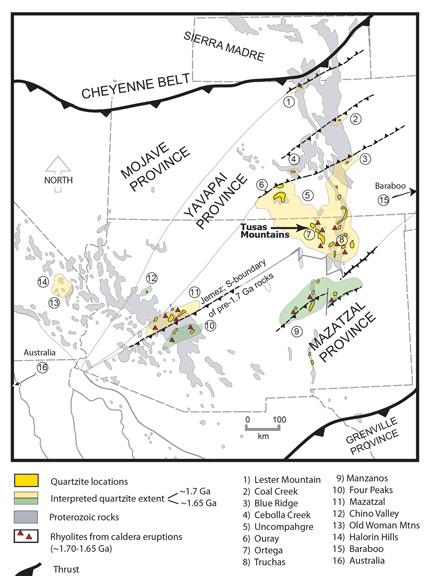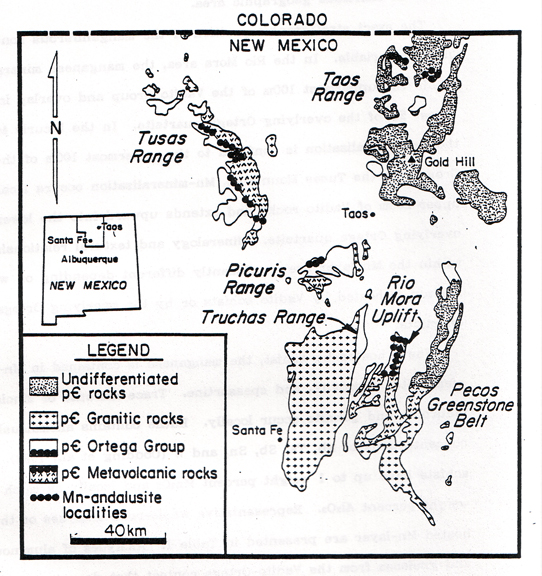|
Characterization
of the Mn-horizon in the Tusas Mts., Northern New Mexico
|
|
|
|
Above
Left: Map of the SW US showing quartzite
and rhyolite localities and their relation to province boundaries
(from Kopera, 2003).
Above Right: Map showing the location of the Tusas Mts.
in relation to other basement-cored uplifts of Paleoproterozoic
age (from Williams, 1987).
|
|
The
cratonic core of the North American continent was assembled in
the Proterozoic from smaller Archean microcontinents (Hoffman,
1988). This assembly was followed by the genesis of a long-lived,
active margin at the southern edge of the craton, at which significant
amounts of crust were added through accretionary orogenic events
of the Proterozoic (Karlstrom and Bowring, 1987). During this
time, the North American continent grew considerably southward.
Rocks of the accreted Proterozoic terrane are well exposed in
the southwestern US (see maps above) and represent the ideal location
for the investigation of Proterozoic plate tectonic processes.
A distinctive feature of this terrane is the occurrence of km-thick
sequences of mature, syn/intra-orogenic, metamorphosed quartzarenite.
In the Tusas Mts and across the southwestern US, an anomalous
Mn-horizon can be found spanning across the basal contact of the
quartzites and characterized by the occurrence Mn-rich phases
(esp. Mn-andalusite) in areas of higher metamorphic grade (Williams,
1987). The source of the Mn-horizon is still unknown, although
presence of Mn-rich phases on cross-beds in the quartzite points
to a sedimentary origin.
Studies
of structural fabrics and metamorphic assemblages linked with
geochronology have constrained three periods of Proterozoic deformation
(D1, D2, D3) (Williams, 1991). Interpretation of the character,
intensity, and timing of the different deformations has become
an issue of debate. Careful interpretation of the tectonic and
deformational history of the southwestern US still remains key
to understanding how the southern margin of the North American
continent evolved in the Proterozoic.
In
this project, detailed study of the Mn-rich phases and related
assemblages will be used:
(1) as a tool to understand the origin of the Mn-horizon (particularly
if linked to quartzite deposition),
(2) as a marker unit to correlate quartzite localities across
the southwest, and
(3) as a tool to compare the timing of the growth and deformation
of Mn-phases
A detailed
study of the Mn-horizon could serve as the critical link when
comparing isolated Proterozoic outcrops across the southwestern
US. It may be the marker unit that links southwestern US quartzite
localities together both in origin and in character of depositional
environment (a character that could represent conditions unique
to this time in the Proterozoic). The Mn-horizon may also be the
link that finally provides the tools necessary to compare the
effects of deformational events on a regional scale and shed light
on the extent to which these events may have played a role in
the accretion and evolution of crust at the southern margin of
the North American continent in the Proterozoic.
|
|
|
Hopewell Lake-Jawbone Mt. Area
|
|
|
|
|
..
|
Above:
Photo of the a small ridge of quartzite of the Ortega Fm near
the base of the unit where the Mn-horizon can be found.
Right: A photomicrograph of a Mn-andalusite crystal from
the locality featured above (x-pol). Variation in birefringence
directly cooresponds to Mn abundence. Oxide inclusion trails
trace the dominant fabric. |
|
| |
|
|
Kiawa
Moutain
|
|
|
|
|
Above
Left: Photo from the peak of Kiawa Mt. where the occurance of
Mn-andalusite marks the location of the Mn-horizon.
Above Right: A photomicrograph of a rock from Kiawa Mt. showing
relationships between kyanite, Mn-andalusite, and accessory phases. |
|
References
Hoffman,
P.F. 1988. United Plates of America, the birth of a craton. Annual
Reviews of Earth and Planetary Sciences, 16, 543-603.
Karlstrom,
K.E. and Bowring, S.A., 1987. Early Proterozoic assembly of tectonostratigraphic
terranes in southwestern North America. Journal of Geology, 96,
561-576.
Kopera,
J., 2003. Monazite geochronology of the Ortega Quartzite: Documenting
the extent of 1.4 Ga tectonism in northern New Mexico and across
the orogen. Unpub. M.S. Thesis, University of Massachusetts, Amherst.
Williams,
M.L., 1987. Stratigraphic, structural, and metamorphic relationships
in Proterozoic rocks from northern New Mexico. Unpub. PhD. Thesis,
University of New Mexico, Albuquerque.
Williams,
M.L., 1991. Heterogeneous deformation in a ductile fold-thrust
belt: The Proterozoic structural history of the Tusas Mountains,
New Mexico. GSA Bulletin, 103, 171-188.
|
|

